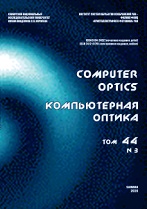|
OPTO-IT
Application of the coupled classical oscillators model to the Fano resonance build-up in a plasmonic nanosystem
P. A. Golovinskiab, A. V. Yakovetsb, E. S. Khramovb
a Voronezh State Technical University, 20 let Oktyabrya st., 84, Voronezh, 394006, Russia
b Moscow Institute of Physics and Technology (State University), 9 Institutskiy per., Dolgoprudny, Moscow Region, 141701, Russia
Abstract:
We study the excitation dynamics of Fano resonance within the classical model framework of two linear coupled oscillators. An exact solution for the model with a damped harmonic force is obtained. Details of the growth of a Fano profile under the harmonic excitation are shown. For an incident ultra-wideband pulse, the reaction of the system becomes universal and coincides with the time-dependent response function. The results of numerical calculations clarify two alternative ways for the experimental measurement of complete characteristics of the system: via direct observation of the system response to a monochromatic force by frequency scanning or recording the time-dependent response to a d-pulse. As a specific example, the time-dependent excitation in a system consisting of a quantum dot and a metal nanoparticle is calculated. Then, we show the use of an extended model of damped oscillators with radiative correction to describe the plasmon Fano resonance build-up when a femtosecond laser pulse is scattered by a nanoantenna.
Keywords:
Fano resonance, model of coupled oscillators, ultrashort laser pulse, nanoantenna.
Received: 13.03.2019
Accepted: 10.06.2019
Citation:
P. A. Golovinski, A. V. Yakovets, E. S. Khramov, “Application of the coupled classical oscillators model to the Fano resonance build-up in a plasmonic nanosystem”, Computer Optics, 43:5 (2019), 747–755
Linking options:
https://www.mathnet.ru/eng/co699 https://www.mathnet.ru/eng/co/v43/i5/p747
|

| Statistics & downloads: |
| Abstract page: | 152 | | Full-text PDF : | 51 | | References: | 21 |
|




 Contact us:
Contact us: Terms of Use
Terms of Use
 Registration to the website
Registration to the website Logotypes
Logotypes








 Citation in format
Citation in format 